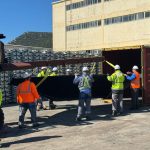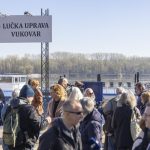Could Croatia ever possibly compete with skiing giants like nearby Austria? Yes… and no.
As Index/Nenad Jarić Dauenhauer writes on the 4th of March, 2018, as Croatia and most of the rest of Europe has been captured and frozen by the recent wave of extreme cold, adverse conditions in the past few days, and the white stuff emerged even in the southernmost towns and islands of Dalmatia, certain questions have arisen…
While hardly ideal for most people, the wintery conditions re-ignited one of the country’s apparently eternal, yet seasonally induced questions in the media and across numerous social media networks – Could Croatia become an attractive ski resort?
Could Croatia’s totally overlooked Delnice ever become something like nearby Austria’s Villach? Could Croatian skiers, and there are many excellent ones, at least spend a bit of their time in domestic ski resorts to keep a good slice of that big tourist cake right here at home as opposed to travelling abroad annually? Is this just a matter of a good idea and a smart investment or two, or is it something else?
Experienced skiers will likely largely agree that Croatia will never become a skier’s paradise unless by some miracle, climate change turns on some sort of cooling effect as opposed to warming things up. The basic logic is pretty simple – Croatia’s rugged mountains are incredibly beautiful, but aren’t particularly high, there are no glaciers or areas with constant, guaranteed year-round snow, the paths wouldn’t be long, and most of the country’s mountains are located by the sea, where, whenever snow does fall, it quickly softens and melts, so that it becomes more suitable for bone fractures than for any sort of comfortable or remotely safe skiing.
While some of the answers to this question may be blindingly obvious, what does serious climatic data and expert analysis say?
Less snow, less days, more insecurity…
At Index’s request, the State Meteorological Institute (DHMZ) made a comparison of snow conditions in several of our potential ski destinations with several in Austria. But at the very beginning, DHMZ issued a warning that general statistical insight into climate conditions alone is sufficient to estimate the economic viability of a particular location for winter tourism.
The following areas were chosen in Croatia:
Gospić (alt = 564 m)
Puntijarka (alt = 988 m)
Delnice (alt = 681 m)
Begovo Razdolje (alt = 1070 m)
Using multi-year climatological data from the period from 1981 all the way up to 2010, there has been much more data on the amount of snow in these locations.
Measured average annual amount of new snow:
Gospić 170.7 cm
Puntijarka 249.0 cm
Delnice 244.3 cm
Begovo Razdolje 293.5 cm
The maximum measured snow levels per day are:
Gospić 117 cm
Puntijarka 127 cm
Delnice 175 cm
Begovo Razdolje 158 cm
Average number of days per year with more than 30 cm snow:
Gospic 14.2
Puntijarka 41.5
Delnice 34.4
Begovo Razdolje 54.8
However, the DHMZ points out that the snow cover at the aforementioned Croatian locations is not particularly stable, nor is it all that reliable. It’s therefore possible that in some years, there were only a few days in individual locations with a good snow cover of more than 10 cm.
Austria sees more snow, more days, more security…
The comparison was made with Austria with locations where the data was collected from the period between 1971 to 2000.
Villach (alt = 492 m) in the Kärnten region
Kitzbuehel (alt = 763 m) in the Tirol region
Saalbach (alt = 1022 m) one of Austria’s top ski resorts although its altitude is relatively low
Average annual amount of new snow:
Villach – 93.5 cm
Kitzbuehel – 205.6 cm
Saalsbach – 395.7 cm
The maximum measured daily snow depths are:
Villach – 94 cm
Kitzbuehel – 112 cm
Saalsbach – 154 cm
Average number of days per year with snow coverage deeper than 20 cm:
Villach – 30 days
Kitzbuehel – 45 days
Saalsbach – 94 days
Although it can be clearly seen from the stated data that Austrian skiing destinations have more snow in each of the different categories, these differences don’t seem to be as large as you’d really expect them to be at first sight. However, with that being said, Croatian climatologists point out that Croatian destinations simply cannot guarantee potential skiers a longer amount of days with high-quality snow, which is obviously of crucial importance when assessing economic feasibility for such an idea or potential project or investment.
Bjelolasica’s unrealised dreams…
In order to get a clearer picture of what makes sense in Croatia when it comes to the possibility of investments of this kind, and in winter tourism in general, Index attempted to find answers from the Ministry of Tourism. But the Croatian media giant was informed that the competent ministry was unable to offer them contact with the correct individual to get a proper response. Instead, Index’s questioning was answered by a rather typical pamphlet where almost nothing was relevant to the topic at hand could be found.
In their search, Index managed to do a lot better with Tomislav Paškvalin, a double water polo olympian who ran the Croatian Olympic Centre in Bjelolasica for ten years, a man who has great experience and first-hand knowledge of the plans, as well as the potential and the problems in Croatia’s development strategy as a winter tourist destination. In its time, the Olympic Centre was market-positioned as a year-round, continental sports and tourist destination for athletes, skiers, schoolchildren, and others.
He recalled that after 1984, when the Winter Olympics in Sarajevo, then Yugoslavia, took place, part of the infrastructure went to Bjelolasica, which, at that time, was supposed to become the Croatian skiing centre. But then, they say, the climatic conditions were quite different than they are today.
“The winters were more normal so it could be better predicted when it would snow. When I came to Bjelolasica personally fifteen years later, I saw a lot of things. I had years with exceptionally strong southern winds (juzina), and even some years without snow, where there was not a single snow day. It was once unthinkable that Bjelolasica didn’t have a day of snow, but even in very snowy years, there were strong southern winds and warm winds that caused huge problems on the Bjelolasica Trail facing south, so it was subject to enormous temperature differences,” Pašvalin stated for Index.
Croatia can’t compete with big brands
In Pašvalin opinion, Croatian mountains with their climatic conditions, their altitudes and their geographical position, generally can’t and will never be able to really compete more seriously with other destinations such as the famous Alps – from Slovenia and Austria, all the way through to Italy, Switzerland, and then France.
“The fact is that we could never become a recognisable ski brand like Austria and Italy; we could never compete with them. They have skiing defined as an important tourist potential, but they also have numerous ski resorts located at altitudes greater than 1500 metres. How would we be able to satisfy a clientele in Croatia who have learned to go to Austria and Italy knowing that there will be snow and high-quality terrain?
What can we in Croatia offer where we could compete with the destinations who’ve been doing this for decades and have the climatic and geographic conditions for it? The real question is, would Croats continue to go abroad if we had something to offer them here? I think they would. The whole time I was working on Bjelolasica, I said that we could become a kind of weekend ski resort where people would come for a day or two warm up before going to a serious, high quality skiing destination. Let’s be realistic, we can’t compete with them even if some serious capital arrived here,” Paškvalin explained.
If there was any potential, there would be interest…
Paškvalin points out that Bjelolasica, which is in bankruptcy, would have attracted very little money even with proper skiing potential.
“Serious investors would be in doubt whether or not even artificial snow would pay off at all at such low altitudes. Bjelolasica does have an advantage over Sljeme and Platak in terms of spreading towards Mrkoplje and Begovo Razdolje and also towards Delnice, so there was an idea of developing a centre there, but the climate conditions didn’t agree with that idea. Bjelolasica would have the potential to be an Olympic centre where skiing was just part of the offer, but there’s not enough content to survive that market considering the competition in an environment that has developed [skiing] for decades, including the period we had a war and when there was a refugee centre there, what do we have in Croatia for skiers today? We have Sljeme without the possibility of spatial expansion, which is simply a city ski resort, and we have Platak which is on offer to people from Rijeka and Istria, which depends on winds a lot, and which also has no possibility of expansion,” Paškvalin said.
Is is too late for Bjelolasica after all?
Paškvalin believes that Bjelolasica had some promising prospects and good projects back in its day, but that it is too late for such things today.
“Today, after years of devastation, I no longer see Bjelolasica as a Croatian Olympic center personally, can it have some other functions? I’ll leave it to any potential investors to assess that,” he said.
Paškvalin rightly stated that such ideas about Croatia as a skiing destination always come up when the snow starts falling.
“Suddenly everyone feels that we can be a ski destination. If the winter remained as warm as it was until recently, nobody would even discuss this subject in their wildest dreams,” concluded Paškvalin.










